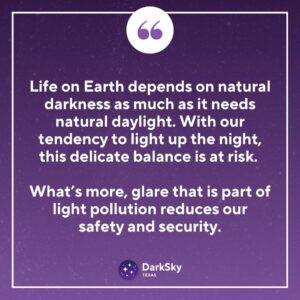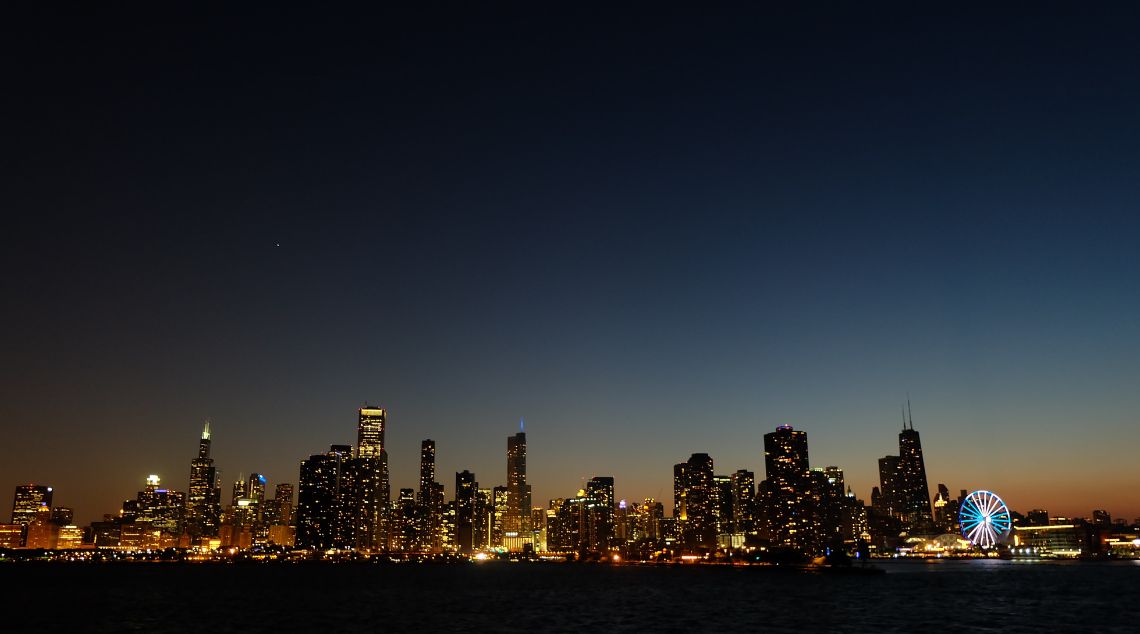The night sky has been one of the few constant sights humans could count on for thousands of years. Now it needs us to protect it.
In its vastness and sparkly depths, the night sky has granted humans strategic learnings in science, navigation, folklore, and timings for agriculture. In Texas, our natural landscapes and weather have granted us a particularly beautiful night sky that has attracted naturalists, tourists, and even astronauts from around the globe.
Life on Earth requires darkness as much as it needs daylight. But as many people and communities incorporate more and more thoughtlessly directed outdoor lighting, this delicate balance is at risk. We have a tendency to light up the night outside without thought of other living things or about how to best select our lighting to see better.
Losing our common view of the night sky is merely one part of the damage from light pollution. The glare that is part of light pollution reduces our safety just when we think we are safe because the area is illuminated. The excessive use of outdoor lights at night in Texas costs hundreds of thousands of dollars each year and adds to the strain on the electric grid. Light trespass is a facet of light pollution that robs Texans of their property rights. Keep in mind, too, that over-lighting is not attractive. As you see, our night sky is important but not the only issue.
What is Light Pollution?
Light pollution is the collection of effects caused by excessive artificial lights outdoors. This includes regular streetlights and the high-powered flood lights used in stadiums, highways, or industrial infrastructure. It also includes residential outdoor lighting when that light is directed upwards or the source of the light can be seen from a neighboring property. In most populated areas, this creates “skyglow”: a blurry or diffuse light across the night sky, distinctly brighter than the natural glow of the Moon or the stars.
Light in the middle of the darkness has revolutionized our schedules and our feeling of safety. But as normal as it may feel to flip the lights on after sunset, it still constitutes a radical change from a nearly eternal natural cycle.
As urbanized areas continue to sprawl and as some in rural areas choose outdoor lighting shining upward or that is not shielded to hide the source of the light from other properties, so do the effects of nighttime artificial lights. Researchers are still measuring the full effects of light pollution – but from what we know, it is clear that our health and the environment are under attack.
Light Pollution Matters to Us All
Each light can make a difference. And combined, they are changing Texas’ landscapes and nightscapes.
- Every year, global sky brightness increases by 9.6%
- 80% of the world’s population lives in areas with “nighttime skyglow”
- Nearly 1/3 of all lights shining out of doors are wasted
Where is Light Pollution at Its Worst?
Light pollution almost always strikes harder around high-density urban areas. However, skyglow often spreads across suburbs, multi-city conurbations, and connecting highways or freeways. Sometimes a single property will create its own skyglow.
Around the world, Western Europe is considered the most light-polluted region in the world, with many areas in Northern France, Belgium, and Germany reaching “daytime color vision.”
The East Coast stands out as the most light-polluted area in the United States. However, the problem is not limited there: in Los Angeles, the sky is now 1.5 times brighter than a regular night with a full moon.
Light Pollution in Texas

Light pollution in Texas follows the same pattern as urban sprawl: it is highest on the Southeast coast, with nearly every area in the Houston-San Antonio-Dallas triangle having excessive levels of skyglow. Amarillo, Lubbock, and El Paso are also heavily affected in the western sections of Texas.
Fortunately, many natural reserves and protected areas of Texas remain “dark night havens.” It’s up to all of us to protect them and extend them!
What Causes Light Pollution In Texas Cities?
Any outdoor artificial light is technically a source of light pollution and is certainly ecological light pollution. A return to complete darkness is not realistic in Texas cities. The fight against light pollution focuses mainly on two types of lights: the ones that scatter beyond or above the property where they are installed and the unnecessary ones lighting an area where there are no people to use the illumination.
Much of light pollution doesn’t come from the direct, “useful” light of the areas we want to illuminate to be able to see well but from excessive light that goes beyond or above that area. Rarely bright enough to be useful, the combined extra light can create wide areas of skyglow. Add cloud coverage, dust, or smog, and the effect multiplies.
Some classic culprits here include:
- Streetlights that face sideways or upwards rather than downwards
- Advertising panels and billboards uplit rather than downlit
- Parking lots with excessive lighting or lighting on when no one is there
- Sports venues that illuminate well beyond the fields
- Factories whose light sources can be seen for miles
- Landscaping installations with unshielded white lights
Many of these lights, such as streetlights in heavily congested areas or at intersections, are necessary for everyday safety. However, just a few tweaks in their choice of shielding, positioning, and color of light can significantly diminish their impact on surrounding areas, curbing useless light pollution and allowing people to see better.
In addition, a large chunk of light pollution comes from places where we don’t necessarily need round-the-clock bright lights. Think of pool or garden lights, closed parking lots, and LED billboards, for example: are we missing anything if we turn them off after the people are gone?
How Does Light Pollution Affect Texas?
Light pollution keeps us from appreciating the night sky as it has always been. The hazy skyglow covering much of Texas makes the stars and the moon look dimmer by comparison. In many areas, even the faint glow of the Milky Way has now taken a step back. The view of the night sky is only one of the issues caused by light pollution.
It’s strange to think about the radical changes the sky has suffered in barely 200 years. But how is this affecting us?
Light Pollution Effects on Human Health
Our internal clocks rely on a certain amount of darkness to tell us when to sleep, eat, or relax. Researchers agree that chronic exposure to artificial light affects our circadian rhythm, which drives many body mechanisms into disarray.
In turn, this can lead to:
- Problems with hormone production
- Higher risk of cardiovascular disease
- Diminished sleep quality
- Insomnia, depression, and anxiety
- Higher rates of breast and prostate cancer
Light Pollution Effects on Wildlife
We are not this planet’s only inhabitants. The glare and skyglow from our excessive outdoor lighting can travel into areas affecting wildlife. The negative affects can be in the plants and living things near the light or miles away.
For animals, having lights where there should be none means:
- Disorientation or problems navigating their natural habitats
- Mistimed breeding or reproductive seasons
- More frequent encounters with predators
- Fewer hours for many insects to pollinate
- Bats and seabirds can get confused or collide against ships, buildings, or each other
- Many bird species need the stars to guide their multi-continent migration patterns.
Light Pollution Effects on Science, Industry, and Safety
Light pollution – especially unnecessary glare and skyglow – is not synonymous with progress. In many cases, it may even hinder it. This can take many forms:
- Economically, it wasted money: approximately 30% of all outdoor lighting in the U.S. is wasted (and someone is paying that bill!)
- The wasted light also represents 21 million tons of carbon dioxide
- Bright billboards and glare on highways increase the risk of car accidents
- A study in Chicago showed that brightly lit urban alleys were less safe and experienced more crime
- Astronomers are now seeing their research affected: it’s harder to get good images from telescopes or satellites
What Can We Do About Light Pollution in Texas?
Reducing light pollution in Texas will take a joint effort from all sectors of society. It falls on all of us – when we install new patio lights, plan new residential developments, or drive at night.
Evaluate each light to determine if it is really needed.
Shielding the light source on all sides, especially for LED lights, will reduce excess glare and maximize the area of “useful” light.
Use only the lowest level of light required. Beware of the surface conditions, as some surfaces can reflect light to neighbors and the night sky.
Dimmers, motion sensors, and timers can all help you keep lights on only when needed.
“Warm” lights, with a preference for amber colors that look more like natural stars or moonlight, can minimize the impact of streetlights and other outdoor lighting.
Policymakers and local authorities can protect wildlife nesting or breeding sites from billboards, unnecessary street lights and flood lights.
Image Source: Canva


